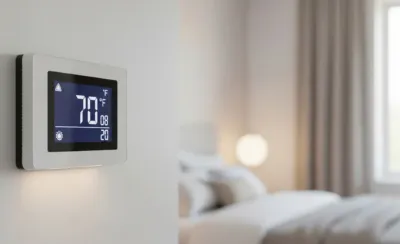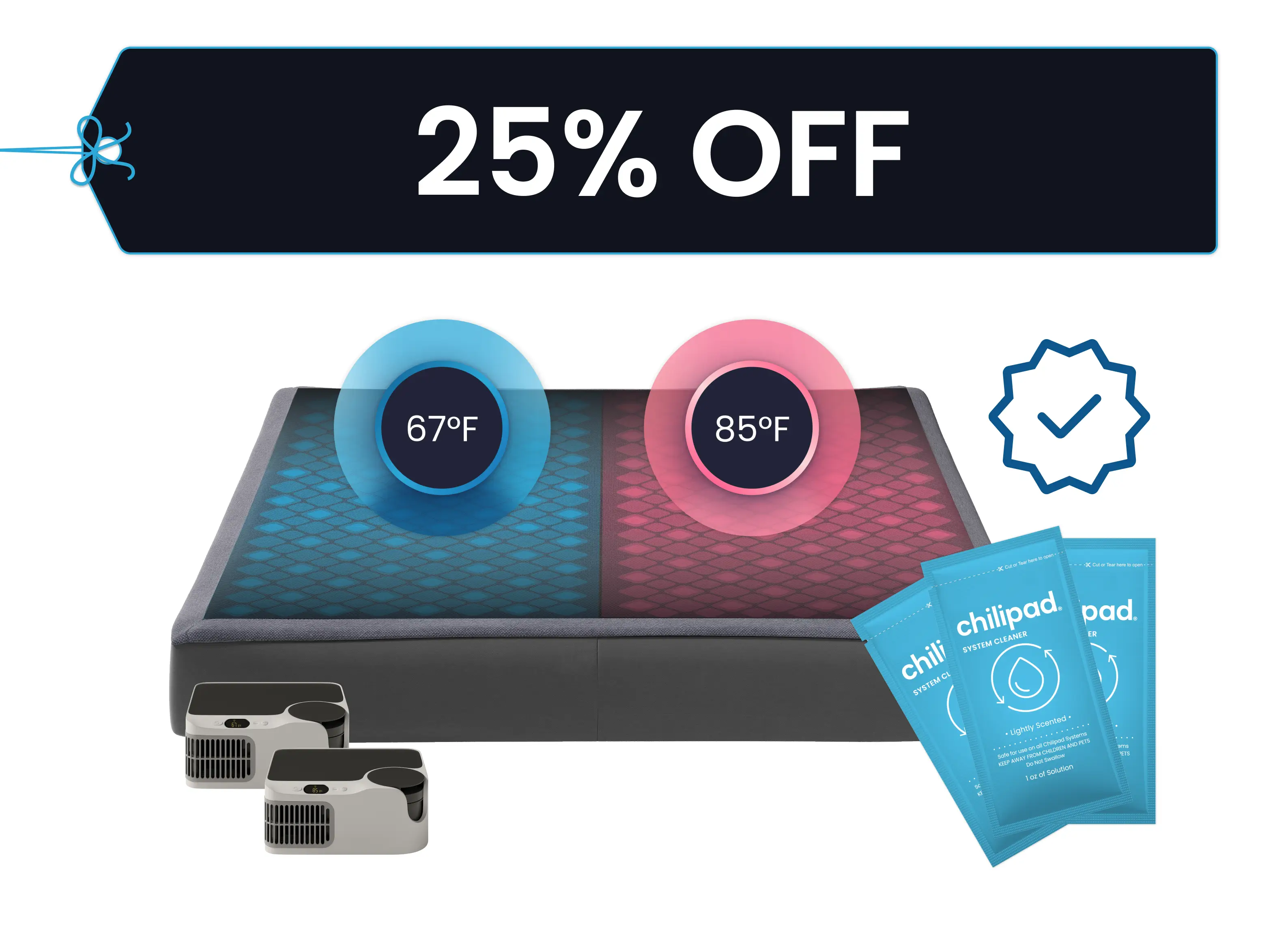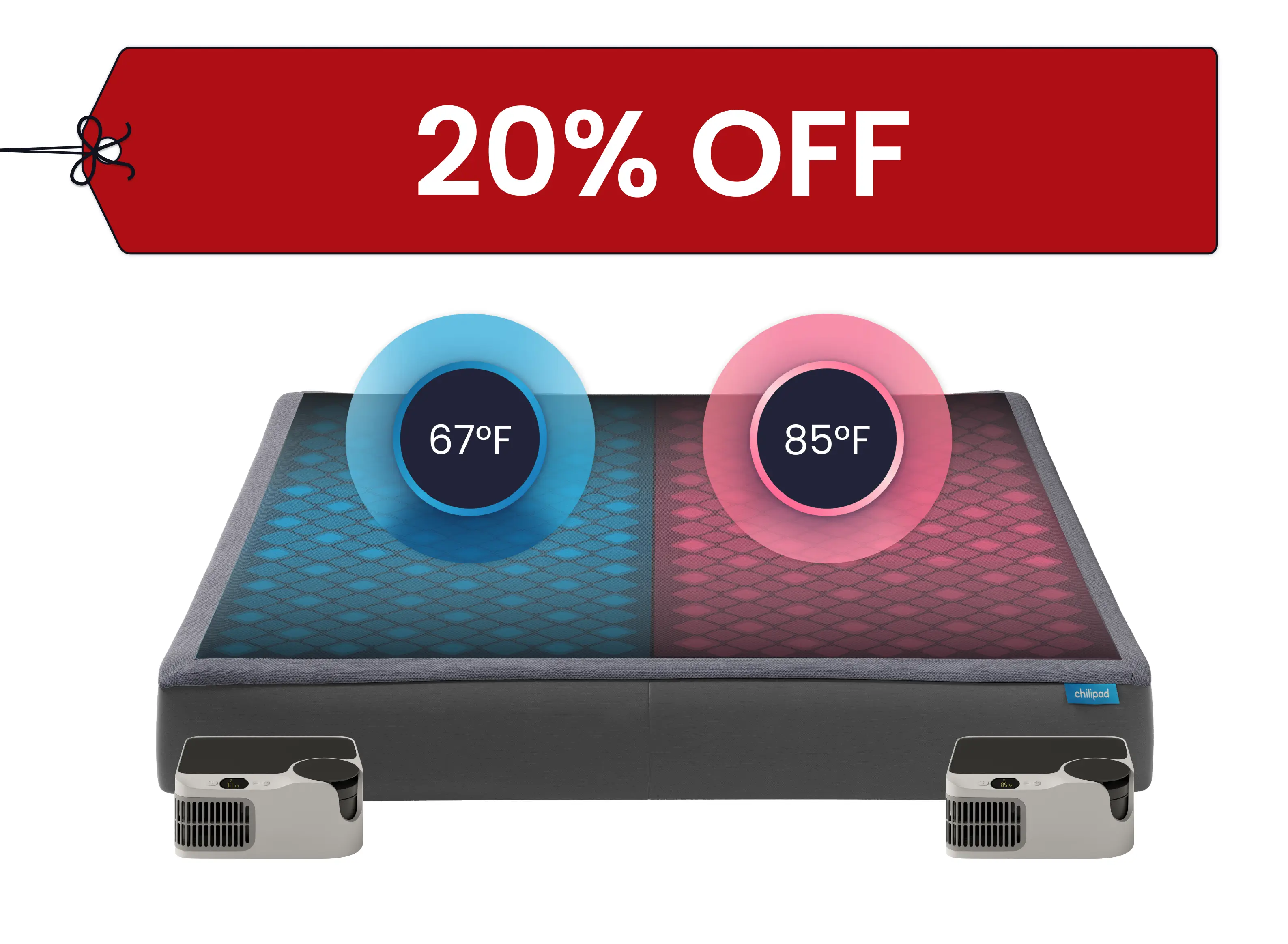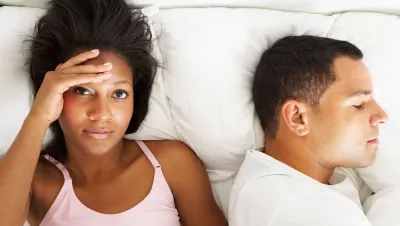
Key Takeaways
- Best Sleeping Temperature: For most people, the best sleep environment is between 60–67°F. This cooler range signals to your body it’s time to sleep and helps you get deeper sleep.
- Body Cooling: At night, your core temperature naturally drops. Sleeping in a cool room supports this process, making it easier to fall asleep and stay asleep.
- REM Support: A cooler bedroom can also increase time spent in REM sleep. The stage is tied to memory, recovery, and emotional balance.
- Overheat Problems: When your bedroom is too warm, it often leads to restlessness, tossing and turning, and wake-ups you might not even notice.
- Smart Solutions: If temperature is hard to control, bed cooling systems and breathable, temperature-regulating bedding can create the perfect environment for sleep.
Ever wake up sweaty, groggy, or tangled in your sheets after a restless night? The problem may not be your mattress or bedtime habits. It could simply be your bedroom temperature. The right sleep environment makes a huge difference for how well you sleep, and the wrong one can leave you dragging the next day.
Temperature is often overlooked, but it’s one of the biggest factors in sleep quality. Below, we’ll look at what science says is the ideal sleep temperature, how your body responds to heat and cold at night, and expert tips for setting up a better space.
No matter if you sleep hot, cold, or somewhere in between, tools like the Chilipad can help you fine-tune your bedroom for your best night’s sleep.
The Optimal Sleep Temperature
Studies show the best sleep usually happens in a room set between 60–67°F (15–19°C). [1] This range lines up with your body’s natural cool-down at night, which signals it’s time to sleep.
Keeping your bedroom on the cooler side makes it easier to fall asleep quickly and stay in deeper, more restorative sleep cycles.
Find Your Perfect Temperature with the Chilipad
Want better control over how warm or cool your bed feels? The Chilipad makes it easy to set your ideal sleep temperature and keep it steady all night.
Why Bedroom Temperature Matters?
Finding the right sleep temperature isn’t just about comfort, it directly affects how easily you fall asleep, how long you stay asleep, and how well you feel in the morning.
Core Body Temperature Regulation
As bedtime approaches, your core body temperature starts to dip—a built-in cue that it’s time to wind down. Keeping your room cool works with this natural rhythm, helping you drift off more easily. During sleep, your body temperature can drop by 1 to 2 degrees Fahrenheit, and a cooler sleep environment helps that transition happen smoothly.
Quality of Sleep
Studies indicate that individuals who sleep in cooler environments tend to experience fewer awakenings and longer periods of deep sleep at night. A drop in body temp can also enhance melatonin production, a hormone that regulates sleep. [2]
Research has shown that temperatures above 75°F can throw off your nightly rhythm, causing increased wakefulness, more tossing, turning, and less restorative rest overall. [3]
Comfort
Getting too warm at night can cause restlessness and frequent wake-ups. A cooler room helps you stay comfortable and undisturbed. In fact, a study published in The Journal of Sleep found that people in cooler environments reported better overall quality of sleep than those in warmer settings. [4]

How Does Temperature Affect Sleep?
Temperature has a big impact on how well and how long you rest. Here’s how it can make or break your rest:
Sleeping Too Hot
As you wind down for the night, your body naturally cools down to get ready for rest. That’s why burrowing under the covers feels so relaxing. But if your room is too hot or stuffy, it can have the opposite effect. Instead of drifting off, you’re more likely to toss, turn, and wake up feeling groggy.
Too much heat is a known Deep Sleep killer. A hot room can push your internal temp up, making it harder for you to enter deep, refreshing rest.
Pro tip: If your bedroom is above 70°F, it’s time to turn down the thermostat for better shut-eye.
Sleeping Too Cold
Chilly nights might feel refreshing, but sleeping in a room that’s too cold can come with its own set of problems. While it may not throw your sleep cycles out of whack like heat does, it can still take a toll on your body.
Did You Know: A study found that cooler temps don’t disrupt your sleep cycle nearly as much as excessive heat does. [5]
When you're too cold, your system goes into overdrive to warm you up—tightening blood vessels, making breathing more shallow, and putting extra stress on your cardiovascular system. Not exactly the recipe for restful sleep. But that’s where the
Chilipad steps in. It gives you full control over your bed’s climate—cool it down, warm it up, or land somewhere in the sweet spot, so your body doesn’t have to fight to get comfortable. Effortless, all-night comfort at the tap of a button.
Quick Tip: If your bedroom temperature dips below 60°F, it’s probably time to bump up the temp a bit for a healthier, more comfortable night’s rest.
Here are a few more ways temperature can make or break your sleep game:
- Sleep Onset: A cooler room helps your body start its natural cooling process, so you can fall asleep faster. If your bedroom is too warm, that process gets delayed, making it harder to drift off.
- Sleep Stages: Your body needs different conditions for different stages of sleep. During REM (Rapid Eye Movement) sleep, temperature regulation isn’t as effective, which makes you more sensitive to external changes. A cooler environment helps keep things stable so you get better sleep.
- Sleep Disruptions: Sleeping in a hot room often leads to tosses, turns, and wake-ups throughout the night. These interruptions can keep you from reaching deep, restorative stages of sleep.
The Science Behind Sleep Temperature
Understanding the science behind sleep temperature can help you appreciate its importance. The body’s circadian rhythm, which regulates sleep-wake cycles, is closely linked to temperature changes. As night falls, the body cools, preparing for sleep. This cooling process is influenced by several factors, including:
Metabolism
Your metabolism slows down at night, which naturally lowers your body temperature. Sleeping in a cool environment supports this process and helps your body ease more smoothly into sleep.
Thermoregulation
Your body’s temperature is controlled by the hypothalamus, a part of the brain that responds to changes in your environment. If your room is too warm, the hypothalamus has a harder time cooling you down, which can cause discomfort and disturb your sleep.
Sleep Stages
Each stage of sleep has different needs when it comes to temperature. During REM (Rapid Eye Movement) sleep, your body isn’t as effective at regulating temperature, which makes you more sensitive to the room’s climate.
Keeping your environment cool helps stabilize body temperature and supports this important stage of rest.
Sleep Expert Recommendations
To help you stay comfortably cool (or warm) through the night, here’s what sleep experts recommend for dialing in the ideal sleep temperature:
Bedding and Sleepwear
Look for lightweight, breathable fabrics in your bedding and pajamas to stay comfortable through the night. Materials like cotton and bamboo are great choices since they allow airflow and wick away moisture to keep your body cool.
Avoid synthetic fabrics, which trap heat and sweat, leaving you hot and uncomfortable.
Cooling Products
Adding cooling sleep products can make a big difference in comfort. Options like cooling mattresses, pillows, and mattress protectors help reduce heat buildup.
For even more control, systems like the Chilipad Dock Pro or Chilipad Cube use water-based technology to actively circulate cool temperatures and keep your bed in the ideal zone all night long.
Bedroom Environment
Make sure your bedroom has good airflow to keep the temperature comfortable. Fans or air conditioning can help, while lighter blankets prevent heat from getting trapped. A well-ventilated space supports steady cooling and promotes better-quality sleep.
Tips for Better Sleep Temperature & Environment
Pre-Sleep Routine
Lowering your thermostat before bed helps signal to your brain that it’s time to rest. Pair this with calming activities like reading, meditation, or gentle stretching to ease into sleep.
Personal Preferences
While cooler rooms are generally best, everyone’s comfort level is different. Experiment with slightly warmer or cooler settings until you find what feels right for your body.
Humidity Levels
Temperature isn’t the only factor—humidity matters too. Aim for levels between 40% and 60%. High humidity can make a room feel hotter, while air that’s too dry may cause skin or breathing discomfort. A humidifier or dehumidifier can help keep things balanced.
Limit Electronics
Electronics give off heat and can make your bedroom warmer than it should be. Try to cut back on device use in the bedroom, especially before sleep, and opt for relaxing wind-down habits like a warm bath instead.
Plus, reducing exposure to blue light from screens supports healthier sleep.
Final Thought
Great sleep isn’t just about how many hours you log—it’s about how well your body recharges during that time. Temperature plays a bigger role than most people think. From syncing with your natural circadian rhythm to keeping you in deeper, more restorative stages of rest, the right environment can transform the way you sleep.
For most, the sweet spot falls between 60–67°F. Still, everyone’s ideal temperature is a little different—and that’s where the Chilipad makes all the difference. Giving you control over your bed’s climate helps you find the setting that feels best for your body.
No more night sweats. No more chills. Just personalized comfort that sets you up for your best night’s rest.
Frequently asked questions
Is 72º Too Hot to Sleep?
For many, yes. The ideal sleep temp is 60º–67ºF. At 72º, your body may struggle to cool down, leading to restless nights and lighter sleep. If you find yourself tossing and turning, sweating, or kicking off the covers at night, your thermostat may be the silent culprit.
Try dialing it down a few degrees—your sleep (and mood) may thank you.
What is a Healthy Sleep Temperature?
A healthy sleep temperature sits comfortably between 60° and 67°F. This range helps signal your body that it’s time to wind down by mimicking your natural nighttime drop in core temperature. Too hot, and you’ll toss and turn.
Too cold, and your body kicks into heat-preserving overdrive. Goldilocks had it right—aim for “just right.” Smart sleep tech, breathable bedding, and a well-calibrated thermostat can all help you lock in the perfect chill zone.
Is It Better to Sleep Warm or Cold?
Cooler wins. A room between 60°–67°F helps your body naturally lower its core temperature—key for falling asleep faster and staying in deep, restorative sleep. Too warm? You’re likely to toss, turn, and overheat. Too cold? Your body fights to stay warm, disrupting rest.
The sweet spot: cool, dark, and cozy—not hot or icy.
References
[1] Doheny, Kathleen. “Can’t Sleep? Adjust the Temperature.” WebMD, 23 Mar. 2022. View Study
[2] ibid
[3] Zheng, Guozhong et al. “The Effects of High-Temperature Weather on Human Sleep Quality and Appetite.” International journal of environmental research and public health vol. 16,2 270. 18 Jan. 2019, doi:10.3390/ijerph16020270. View Study
[4] Chevance, Guillaume, et al. “A Systematic Review of Ambient Heat and Sleep in a Warming Climate.” Sleep Medicine Reviews, vol. 75, 6 Mar. 2024, p. 101915. View Study
[5] CTroynikov, Olga et al. “Sleep environments and sleep physiology: A review.” Journal of thermal biology vol. 78 (2018): 192-203. doi:10.1016/j.jtherbio.2018.09.012. View Study









